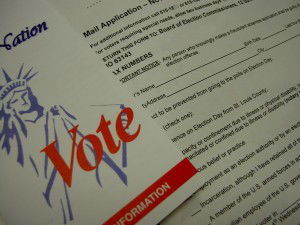Shelby v. Holder: Supreme Court Invalidates Key Provision of Voting Rights Act

Over forty-five years after Congress passed the Voting Rights Act of 1965, a deeply divided U.S. Supreme Court has invalidated one of its key provisions. By a vote of 5-4, the Court ruled that Section 4, which establishes states and municipalities that must obtain federal approval before changing their voting laws, is unconstitutional.
The Facts of the Case
Petitioner Shelby County, in the covered jurisdiction of Alabama, sued the Attorney General, seeking a declaratory judgment that sections 4(b) and 5 are facially unconstitutional, as well as a permanent injunction against their enforcement. Section 4 of the Act provides the “coverage formula,” defining the “covered jurisdictions” as States or political subdivisions that maintained tests or devices as prerequisites to voting, and had low voter registration or turnout, in the 1960s and early 1970s. In those covered jurisdictions, Section 5 of the Act provides that no change in voting procedures can take effect until approved by federal authorities. Such approval is known as “preclearance.”
The District Court upheld the Voting Rights Act, finding that the evidence before Congress in 2006 was sufficient to justify reauthorizing Section 5 and continuing Section 4(b)’s coverage formula. The D. C. Circuit affirmed. After surveying the evidence in the record, that court accepted Congress’s conclusion that litigation remained an inadequate remedy to protect the rights of minority voters. It further found that Section 5 was therefore still necessary, and that the coverage formula continued to pass constitutional muster.
The Supreme Court’s Decision
The majority of the Supreme Court disagreed. They held that Section 4 of the Voting Rights Act is unconstitutional. More specifically, its formula can no longer be used as a basis for subjecting jurisdictions to pre-clearance.
“Our country has changed,” Chief Justice John G. Roberts Jr. wrote in the Shelby v. Holder. “While any racial discrimination in voting is too much, Congress must ensure that the legislation it passes to remedy that problem speaks to current conditions.”
The majority was also highly critical of the data used to reauthorize the Act and the coverage formula. “Congress — if it is to divide the states — must identify those jurisdictions to be singled out on a basis that makes sense in light of current conditions,” Roberts explained. “It cannot simply rely on the past.”
In its opinion, the majority did not expressly strike down Section 5 and, thus, left the door open for Congress to create a new formula. However, the tone of the majority opinion suggests that the current Court would likely be highly skeptical of any new legislation.
Ultimately, the justices’ decision followed ideological lines. Justice Ruth Bader Ginsburg authored a strongly worded dissent, which was joined by Justices Stephen G. Breyer, Sonia Sotomayor, and Elena Kagan.
“The sad irony of today’s decision lies in its utter failure to grasp why the VRA has proven effective. The Court appears to believe that the VRA’s success in eliminating the specific devices extant in 1965 means that preclearance is no longer needed. With that belief, and the argument derived from it, history repeats itself… In truth, the evolution of voting discrimination into more subtle second-generation barriers is powerful evidence that a remedy as effective as preclearance remains vital to protect minority voting rights and prevent backsliding,” Ginsberg argued in the dissent.
Previous Articles
Supreme Court Cases to Watch in the October Sitting
by DONALD SCARINCI on October 23, 2025
The U.S. Supreme Court’s new term, which began on October 6, has the potential to be historic. In...
SCOTUS Clears Way for Termination of FTC Commissioner
by DONALD SCARINCI on October 17, 2025
The U.S. Supreme Court’s emergency order in Trump v. Slaughter, 606 U.S. ____ (2025), allows Pres...
U.S. Supreme Court Adds Tariff Case to Docket
by DONALD SCARINCI on October 15, 2025
The U.S. Supreme Court has agreed to consider two lawsuits challenging President Donald Trump’s n...
The Amendments
-
Amendment1
- Establishment ClauseFree Exercise Clause
- Freedom of Speech
- Freedoms of Press
- Freedom of Assembly, and Petitition
-
Amendment2
- The Right to Bear Arms
-
Amendment4
- Unreasonable Searches and Seizures
-
Amendment5
- Due Process
- Eminent Domain
- Rights of Criminal Defendants
Preamble to the Bill of Rights
Congress of the United States begun and held at the City of New-York, on Wednesday the fourth of March, one thousand seven hundred and eighty nine.
THE Conventions of a number of the States, having at the time of their adopting the Constitution, expressed a desire, in order to prevent misconstruction or abuse of its powers, that further declaratory and restrictive clauses should be added: And as extending the ground of public confidence in the Government, will best ensure the beneficent ends of its institution.





